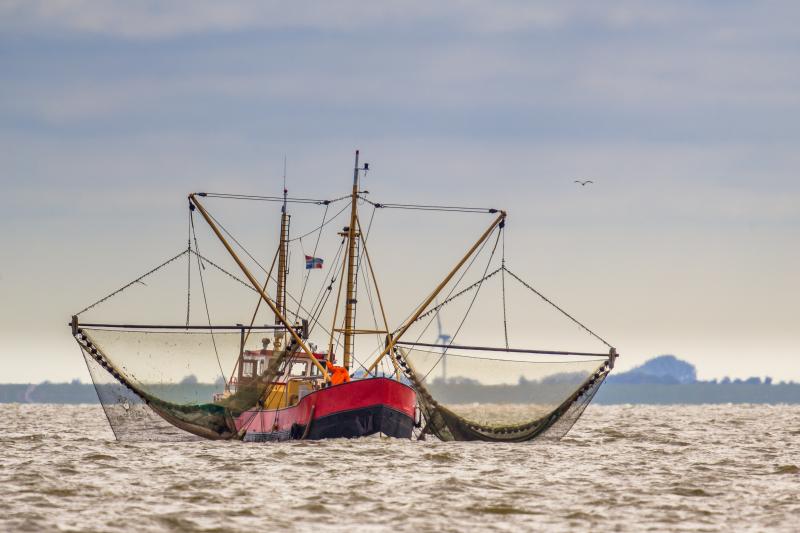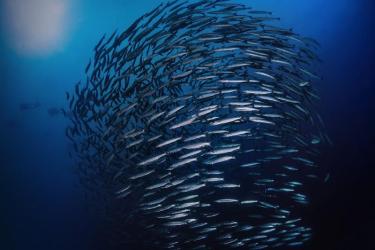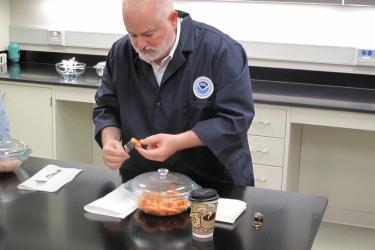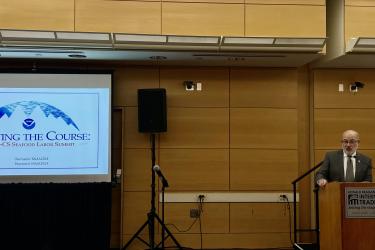At its 12th annual meeting in Ecuador, the South Pacific Regional Fisheries Management Organisation adopted U.S. proposals to improve observer coverage and combat labor abuse in South Pacific fisheries.
Led by NOAA Fisheries, including colleagues from the U.S. Department of State, the U.S. delegation built on important successes from last year’s meeting to continue strengthening management and monitoring of the squid fishery in the South Pacific. This fishery has been the focus of claims of rampant illegal, unreported, and unregulated (IUU) fishing in recent years. U.S efforts led to the adoption of a comprehensive high seas boarding and inspection program last year that significantly increases opportunities for monitoring this fleet.
Combating IUU Fishing through 100 Percent Transshipment Observer Coverage
Many South Pacific Regional Fisheries Management Organisation members have been concerned about the lack of monitoring for at-sea transshipment in the Convention Area, particularly in the squid fleet. A new conservation measure brokered by the United States and co-sponsored by New Zealand will boost observer coverage for transshipment to 100 percent. Unmonitored transhipment, particularly on the high seas, creates opportunities for untraceable seafood products to enter the market. The United States is greatly concerned about the rise of seafood caught by illegal, unreported, or unregulated fishing. This agreement is a huge step forward in assuring sustainably caught seafood for U.S. markets.
“Adoption of the U.S. transshipment measure at this year’s meeting is an important achievement that will help the organization improve monitoring and ensure compliance of vessels fishing in the South Pacific,” said Alexa Cole, Director of the Office of International Affairs, Trade, and Commerce for NOAA Fisheries, who serves as the U.S. Commissioner to the South Pacific Regional Fisheries Management Organisation. “I am extremely pleased that the Commission was able to reach an agreement on these significant improvements that continue to increase our capacity to monitor and regulate the activities of these vessels.”
Improved Monitoring of the Jumbo Flying Squid Fishery
The United States also led the charge to adopt an increase in observer monitoring in the jumbo-flying squid fishery. Repeated concerns have been raised regarding the current levels of observer coverage being below the acceptable scientific standards for purposes of data collection and monitoring compliance. To address this gap, the United States and New Zealand proposed increasing observer coverage, with an allowance for electronic monitoring once the Commission develops standards.
After extensive negotiations, the Commission agreed on an increase of more than 200 percent in observer coverage for the largest fleet in the fishery by September 2025. The new measure will allow progressive increases in observer coverage to a level of 10 percent of fishing days. This coverage could be achieved through a mix of human observers and electronic monitoring.
Last year, with U.S. leadership, the Commission placed limits on the number of vessels engaged in the squid fishery for the first time. This fishery had seen exponential growth in past years, which is now capped. The increased observer coverage further strengthens the management of this fishery.
Paving the Way for Electronic Monitoring
Members adopted a proposal from Ecuador, supported by the United States, to create a new working group to establish electronic monitoring standards. Members will consider the proposal for adoption at next year’s Commission meeting. The United States will chair this important work with support from Ecuador.
Stronger Protection Against Labor Abuses in Fisheries
Members took a critical first step to address labor abuses in the South Pacific Regional Fisheries Management Organisation Convention area. The Commission adopted a decision introduced by the United States, New Zealand, and Australia to establish labor standards on fishing vessels operating in the South Pacific. The decision encourages members to ratify international instruments and adopt national legislation to strengthen labor standards in the fisheries sector. Members are also encouraged to implement measures to eliminate forced labor, ensure a safe working environment, and promote fair terms of employment for fishers.
Recent reports have highlighted cases of labor abuses in fisheries, including the jumbo flying squid fishery. This decision will support actions to protect human rights and pave the way for improved working conditions in South Pacific fisheries.
Taken together, these measures, all adopted by consensus, demonstrate the reach and effectiveness of multilateral engagement. These tools will provide greater protection to the fisheries resources and increased transparency to the operations, and safeguard the crew members on board these vessels.
Promoting Conservation of High Seas Area with Rich Biodiversity (Salas y Gomez and Nazca Ridges)
With U.S. support, the Commission adopted a decision by Chile calling attention to the Salas y Gomez and Nazca Ridges within the work of the organization’s Scientific Committee. This high seas area consists of two underwater mountain chains stretching 1,800 miles. They are among the most unique and ecologically significant areas in the world. Home to at least 82 threatened or endangered species, these seamounts are also an important spawning and nursery area for valuable fisheries. Under the new proposal, the Scientific Committee will evaluate relevant research and data and make management recommendations for the Commission to consider, laying the groundwork for future protection.
Ianelli Lauded for Great Work
The meeting in Ecuador also marked the end of Jim Ianelli’s final term chairing the Science Committee. Ianelli is a member of the U.S. delegation and a senior scientist at NOAA’s Alaska Fisheries Science Center. He was lauded for his exceptional work on behalf of the commission for the last 10 years. “Jim has the trust and respect of all members of the Commission,” said Cole. “The Commission has benefited greatly from his calm and steady leadership, sense of humor, and commitment to ensuring we made decisions that were rooted in good science. His expertise will be greatly missed.”
South Pacific Regional Fisheries Management Organisation
The South Pacific Regional Fisheries Management Organisation manages the long-term conservation and sustainable use of the fishery resources of the South Pacific Ocean. The South Pacific Regional Fisheries Management Organisation Convention applies to the high seas of the South Pacific, covering about a fourth of the Earth's high seas areas. The main species fished in the area are jack mackerel and jumbo flying squid in the Southeast Pacific, and deep-sea species associated with seamounts in the Southwest Pacific.



